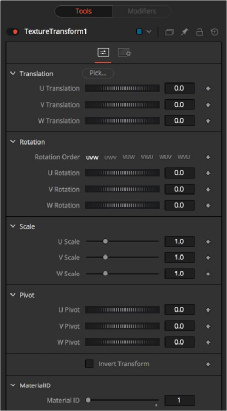
< Previous | Contents | Next >
— Trilinear: An extension of Bilinear filtering. Trilinear tends to be a better option when scaling down textures
— Anisotropic: The highest-quality filtering method that takes the camera orientation and polygon perspective into account.
— SAT: SAT (Summed Area Table) is a method of performing high-quality filtering, but it can require more memory than other options. Works very well on smaller bitmaps.
Common Controls
The Settings tab in the Inspector is duplicated in other 3D nodes. These common controls are described in detail at the end of this chapter in “The Common Controls” section.
Texture Transform [3TT]

The Texture Transform node
Texture Transform Node Overview
![]()
The Texture Transform node can be used to translate, rotate, and scale the UVW texture coordinates of a 3D object. While the input can also be an image, the output is always a material.
Inputs
The Texture Transform node includes a single input that is used to connect the image or material you want to transform.
— Material Input: The orange Material input accepts a 2D image or 3D material whose texture coordinates are transformed using the controls in the Inspector.
Basic Node Setup
The Texture Transform node below is used to take in a 2D image, transform it, and output a material to be used on 3D geometry.

A Texture Transform node transforms a texture applied to 3D geometry.
Inspector

Texture Transform controls

NOTE: Not all Wrap modes are supported by all graphics cards.
NOTE: Not all Wrap modes are supported by all graphics cards.
NOTE: Not all Wrap modes are supported by all graphics cards.
![]()
Controls Tab
The Controls tab for the Texture Transform node includes many common transform controls that are used to transform the texture using UVW coordinates.
The U, V, W translation sliders shift the texture along U, V, and W axes.
Rotation Order buttons set the order in which the rotation is applied. In conjunction with the buttons, the UVW dials define the rotation around the UVW axes.
U, V, W sliders scale the texture along the UVW axes.
U, V, W Pivot sets the reference point for rotation and scaling.
This slider sets the numeric identifier assigned to this material. This value is rendered into the MatID auxiliary channel if the corresponding option is enabled in the renderer.